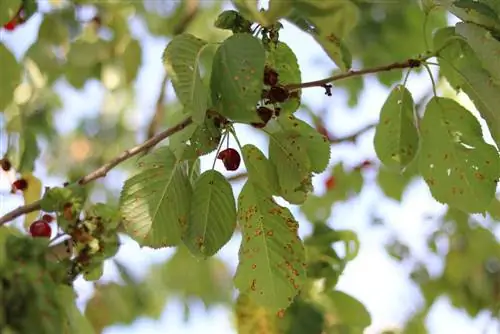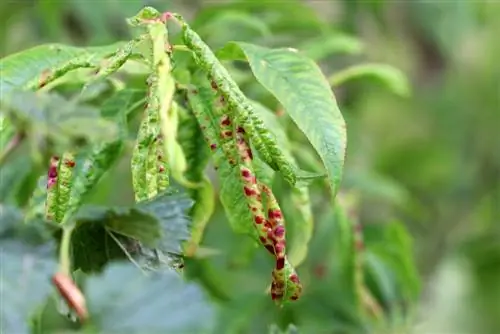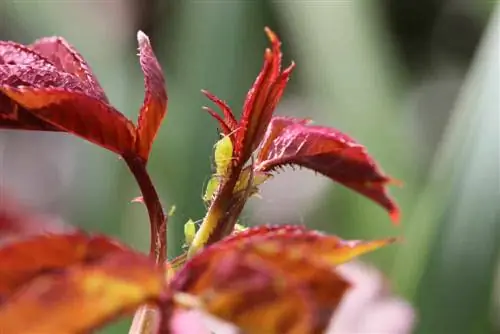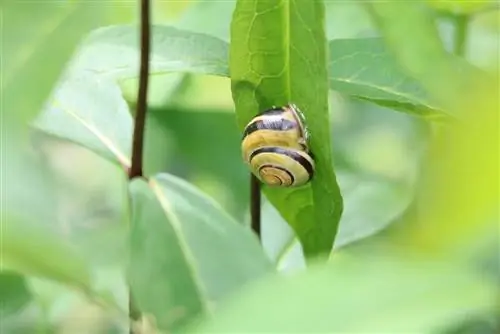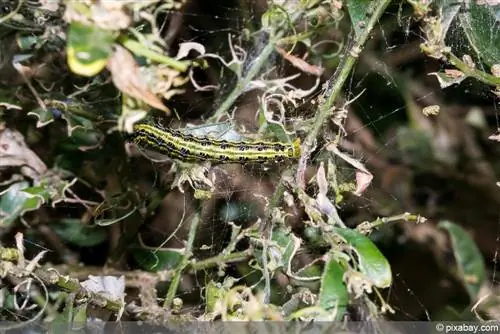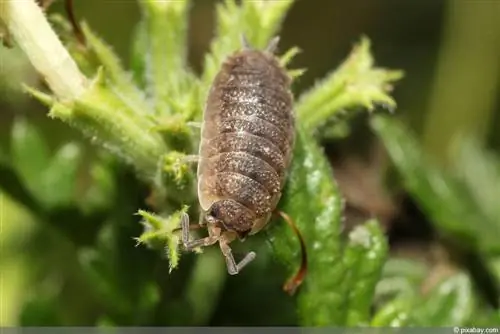- Author admin [email protected].
- Public 2023-12-17 03:39.
- Last modified 2025-06-01 06:48.
Shotshot is a fungus that punctures the leaves of stone fruit plants. However, you will only experience this final phase of the infestation if the fungus colonizes a fruit tree of the Prunus genus in unfavorable weather conditions that has soil that is too moist and you do nothing to combat the fungal infestation. And combating shotgun disease with natural home remedies is not the “organic option”, but rather what the legislature envisages when it obliges home gardeners to observe “good professional practice” in the Plant Protection Act. It doesn't take more than sensible gardening to stop the fungus, and this can usually be done with home remedies.
Symptomatics - recognizing shotgun disease
The name of shotgun disease is derived directly from the symptoms it causes in its most advanced stages: the affected leaves look as if a crazy gardener had fired several gunshots into the tree.
Insert for city children: Shot is the short name for the small metal pellets that hunters shoot in bulk into the butts of rabbits and other unfortunate animals (and because these bullets used to be made of lead, all hunters have them too poisoned who had a piece of meal in their roast).
But this is the final stage, the beginning is much more harmless, here is an overview of the biological development of the shotgun fungus on your fruit tree:
- “Shot in the leaf” is the final stage of stone fruit leaves that have been perforated by a fungus called Wilsonomyces carpophilus
- W. carpophilus is the current botanical name, you will often come across the old name Stigmina carpophila and the synonym Clasterosporium carpophilum
- If not enough research has been done into the most common names, completely different synonyms may appear; the mushroom has 23 synonymous names to offer
- If the weather is so wet in spring that the stone fruit tree often needs a long time to dry (or doesn't dry out properly at all), the shotgun mushroom is happy
- This does not necessarily mean noticeable and noticeable precipitation; Frequent and/or intense fog formation provides the fungus with enough moisture
- A few representatives of this type of mushroom are probably already in your fruit tree
- A garden completely free of shotgun mushrooms is about as likely as a community without athlete's foot
- The fungus attacks the young leaves as soon as they sprout
- The fungus gets “into the plant” by spores penetrating the epidermis or stomata in the tissue
- Small bright dots with a diameter of a few millimeters appear first
- Which turn reddish after a few days (because the fungus germinates) and enlarge to a diameter of approx. 0.5 cm
- The initially sharply defined spots become blurrier in outline, brownish in color and are often surrounded by more delicately colored yellow-reddish zones
- All of this is a sign of a (mostly futile) defense reaction on the part of the plant, which wants to separate infected tissue from he althy tissue
- At some point (usually after about 14 days) the leaf spots break through, then there they are, the shotgun holes
- If it succeeds, the fungus moves into the shoots, which also develop small reddish spots that become larger and browner
- Especially on peaches, it manages to penetrate the shoots via the bases of fallen leaves
- Thinner (peach) shoots can be surrounded by the spots and they then die
- Thicker shoots usually survive the fungus, but can form cancerous galls as a defensive reaction
- The leaves turn yellow after the holes break through the entire area (or the little area that is still there)
- Gum flow can often be observed in the damaged areas, a disease in its own right that can only be cured by cutting it away
- Buds, flowers, fruits can also be affected
- Fruits show sunken, possibly corked brown spots with a red edge, then they become stunted, dry up or rot
- Severely damaged leaves fall off over the summer, affected fruits follow the leaves
- At the end of the season, in extreme cases, only the top area of the crown is left with leaves, while the rest of the tree looks pretty bare
- Once the fungus has gotten this far, it overwinters in the tree, e.g. in infected shoots and stuck fruit mummies
- Most importantly, it overwinters in fallen fruit mummies, leaves, vegetation under the tree, if not every leaf fall is disposed of immediately and the ground is allowed to dry out
- Winter cold and frost have little effect on the fungus, its shoot mycelium even less and the resistant conidia (asexual reproductive spores) have no effect at all
- New spores will be formed early next spring
- They spread with every rain and every drop of water, and the game starts all over again
- If the infection occurs again, the lowest leaves usually suffer the most, as the spores are washed downwards from the infection sites
Tip:
The cherry laurel, which is popular as a hedge plant, also tends to show “shotgun symptoms”; the cultivars ‘Otto Luyken’, ‘Etna’ and ‘Caucasica’ are said to be susceptible. Here the damage is caused in roughly equal parts by shotgun blast and Pseudomonas syringae (bacterial blight, which also produces leaves with shotgun-like holes). In general, it is precisely the particularly good pruning care that is used to raise a densely growing hedge that pays off - both “shotguns” prefer moist plants. You don't have to differentiate, the best defense is always pruning, which brings air into the wood and removes harmful organisms. If you're interested: When it comes to fungal infestation, there are usually signs somewhere like fruiting bodies=fungal coating etc., if these are completely missing, it's bacteria (or you're so early in the fight that no reproductive stages have yet been able to develop, which is all the better is).
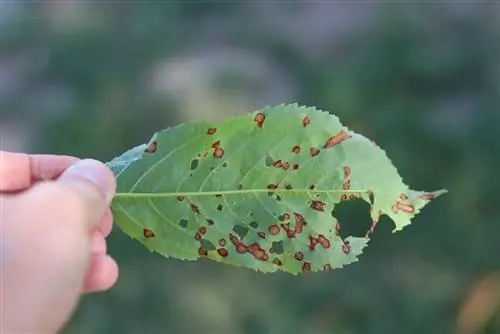
The most important thing with the cherry laurel is to grab the scissors immediately, because the leaves of the evergreen plant hang more firmly on the shoot than the leaf-fall varieties - cherry laurel does not shed infected leaves, which can lead to infection if pruned too late really makes it bloom.
Consequences and relevance of shotgun disease
Without treatment, shotgun disease leads to crop failure and a more or less bare tree during the infestation season. If the fungus develops and spreads extremely in warm, humid weather, the tree as a whole suffers. If the disease is allowed to strike again every year without any treatment, it can eventually lead to the death of a tree. Another aspect certainly plays a role in this warning: If a tree is cared for by a gardener who does not limit the shotgun disease even when the infestation has reached threatening proportions, it is likely that this gardener does not care about his tree anyway taking care of trees. Trees that are completely weakened can even become dangerous if shotgun fungus is present.
In general, however, it can be stated that shotgun fire only becomes a problem in regions with a particularly cool, humid, precipitation-rich climate and/or constant fog formation/dew precipitation (altitudes in low mountain ranges). On trees that should not be planted in such regions, in particularly unfavorable spring weather, and when the “gardener” does not care at all about his tree. In areas with little rainfall, you would probably have to wet the cherry tree every day with a lawn sprinkler to prevent shotgun fungus from becoming a problem (which, by the way, should always be avoided with all Prunus), Shotgun disease is also not a new phenomenon that has suddenly threatened trees in recent times - Wilsonomyces carpophilus was discovered in France in 1853, first mentioned in Iran in 1947, and described by the first German scientist in 1959. Since then, fruit growers have been living with the fungus all over the world where Prunus species are cultivated, which is why the shotgun disease also has many beautiful foreign names: “shothole disease” and “gumspot of stone fruit”, “shoot blight” of cherry, peach, plum, stone fruit, “brûlure corynéenne”, “criblure des amygdalées”, “cribado de los frutales”, “tiro de munición del durazno”. In all these years and in all these countries, the shotgun fungus has not seriously endangered any Prunus species, so the fungus can't be that bad. However, in most of these countries it has no chance of “wallowing in the beloved cold, damp wetness” even if it is placed in the wrong, wet location - the ideal temperature for infections is between 14 and 18 ° C and occurs in countries south of us during the growing season at most at night.
Possible confusion
“Shotshot” caused by bacterial fire is also favored by damp weather (in the initial infection at the time of flowering, fruit ripening and when leaves fall in autumn). But you don't really have to identify the fungus. The immediate measures recommended for the first spot are always the same: cut as many harmful organisms as possible from the plant, dispose of cuttings and fallen leaves to avoid further infection, and strengthen the plant. Even later, both pests have to be kept under control through normal gardening, because no fungicides are permitted against either of them in home and allotment gardens (for good reason, in human-friendly mixtures + quantities, the fungicides would only harden the fungi and bacteria a little more).
The same applies to plum shot (fungus Phoma prunorum) and sieve holes on plums (fungus Sphaceloma pruni), which are recorded as part of general fungal prevention in the garden or when combating shotgun disease.
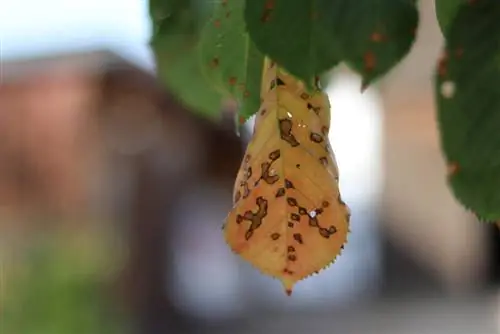
Tip:
In a well-managed garden, you will hardly ever have the embarrassment of having to identify a pathogen. All the “goiter stuff”, fungi, bacteria and the like, is kept in check in the somewhat natural garden through preventive gardening (what it looks like is described in the article “Shotgun disease - what to do about shotgun disease?”). If symptoms of infestation do appear late in the gardening year, you can usually identify the pest much more easily based on the damage pattern and the time when the damage occurred.
Measures against the shotgun disease fungus
Under “Symptomatics” we have introduced you to the complete life cycle of a shotgun mushroom. Of course, that doesn't mean you should "give your mushroom a lot of this life cycle." On the contrary, as explained in the tip, it is best to make life difficult for the fungus if it has not yet conquered your tree. If it can still eat cherries, plums, almonds, you should fight the fungus as soon as you notice it.
Depending on the stage of fungal infestation, the following measures against the fungus are recommended:
- The shot primarily attacks the young leaves that have just sprouted (and only “shoots into these holes” because the plant is only now fast enough to produce the circular defense reaction)
- Cut off affected leaves immediately and dispose of them in such a way that further infection is avoided
- If buds, flowers and later the fruits show discoloration/stains, they will also be cut away and destroyed
- Also thin out tree tops + clear branches so that leaves dry faster
- Disinfect scissors whenever tackling a new area
- If possible, reduce moisture pressure around the plant
- If e.g. B. Side trees “standing in the wind” that are to be pruned or given way anyway, now is the time
- Reducing moisture pressure also includes placing the lawn sprinkler sufficiently far away from trees
- If applicable. Consider moving the plant to a drier location in the fall
- Until then or at all, strengthen the plant
- For example, by planting the tree disc with anti-fungal plants such as garlic, onions, leeks
- Garlic onion broth is a plant antibiotic that can be used for spraying
- This is quite common because garlic and onion broth does not harm, but rather fertilizes
- As soon as the infestation is detected, spray 2 to 3 times at intervals of three days
- Afterwards, from spring until shortly before harvest, spray once every week
- Make stock: Roughly chop 1 part garlic + 1 part onion, bring to the boil with 10 parts water, let simmer for at least 30 minutes
- After cooling, strain through a sieve, dilute with ten times the amount of water before spraying
- The plant is also strengthened by good nutrition for the tree with slow-acting organic fertilizer
- When retaining nitrogen, even when nitrogen is readily available in organic fertilizer (worm humus, etc.)
- Plant strengtheners commonly used against fungi are stinging nettle and field horsetail manure
- You can buy ready-made plant strengthening e.g. B. under the name Neudo-Vital
- The clay preparations that are sometimes recommended can also strengthen plants (that lack the corresponding ingredients)
- But only applied alone, with copper or sulfur they are banned pesticides
- If you're lucky (or have worked consistently), the spook will be over in July
- Older foliage is usually too resilient for shotgun fungus
- In addition, the fungus has now become much too warm, which is why it is usually no longer able to infect new plant mass
- But it gets colder now and then, the fungus can then colonize tender shoots (which also have to be cut off)
- And it gets colder again in autumn, surviving “mushroom remnants” try to get into the tree via open leaf bases after the leaves have fallen
- If in doubt, this late infection is counteracted with another garlic and onion spray treatment
- Falling leaves and fruit mummies should be removed just as consistently as cut-away plant parts, especially during the initial infestation
Tip:
You will read again and again that you should not dispose of infected plant residues in the compost. That's not true; If you use a correctly stacked compost, it will develop temperatures of around 70 °C in the hot rotting phase, which few organisms can survive. A fungus that prefers temperatures around 16 °C and can no longer infect anyone or anything at 35 °C will definitely not survive. The safest way to kill it quickly is to chop up the fallen leaves, layer them in the middle of the compost and immediately cover them well.
Conclusion
If you take consistent action against the fungus in all of the areas mentioned, you have a good chance of avoiding shotgun blasts on the leaves. If you take some of the precautionary measures described under “Shotgun disease - what to do against shotgun disease?” in the season following the infestation, you have a good chance of never seeing holes in the leaves of your Prunus species. And all of this without applying fungicides that are highly toxic to the environment, such as dithianone, trifloxystrobin, etc. (sprayed in intensive commercial fruit production) or “messing around” with critical metals and non-metals such as copper and sulfur (also only permitted in commercial organic fruit production, where the… In contrast to private households, care can be taken when using it).

